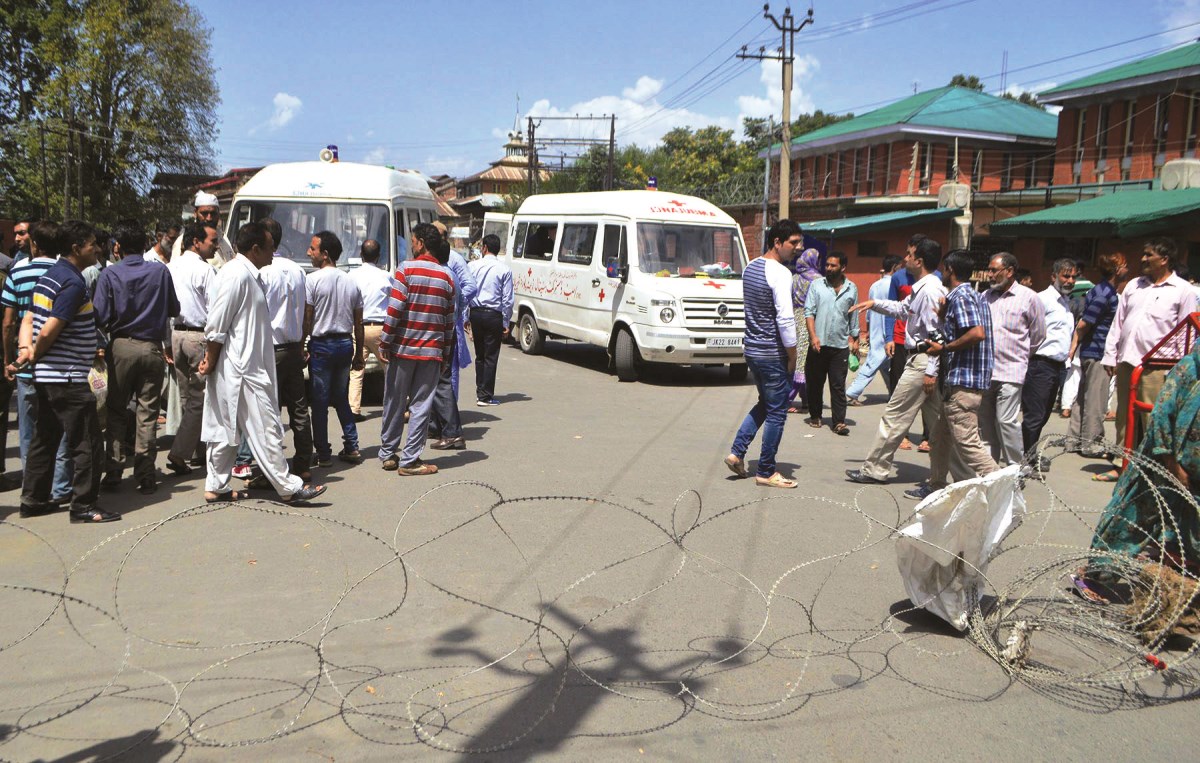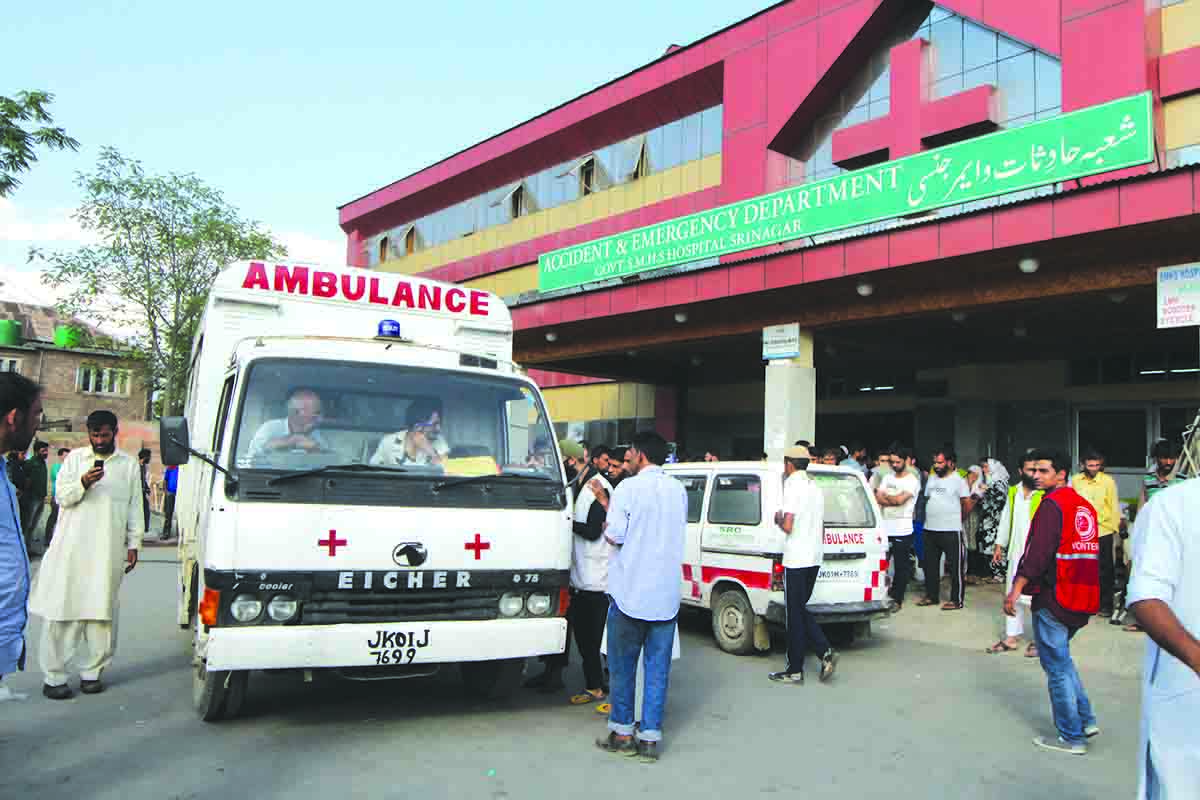A decade after National Health Mission sanctioned 416 ambulances for Jammu and Kashmir, the vehicles are yet to arrive, reports Saima Bhat

“Hello. Aap ka swagat hai 102 helpline mei. Hum kaisey aap ki madat karsaktey hai..(You are welcome on 102 helpline. How can I help you)” is the voice that greets every caller on the ambulance helpline. But as the caller asks for an ambulance he is informed that although the helpline has 416 ambulances the service has not been started yet. “Shama karey, aap dobara call kar saktey hai (we are sorry. You can call us again).”
The Jammu and Kashmir administration had recently announced it will soon be launching the much-awaited fleet of ambulances with Advanced Life Support (ALS) and Basic Life Support (BLS) for the patients. The National Health Mission has already approved Rs 61.23 crore for the project.
The ambulances are supposed to be equipped with a Global Positioning System (GPS). They will be available to ferry trauma cases and critically ill patients to hospitals free of cost. In the first instance, a fleet of 116 ambulances will be launched: 50 will be retrofitted for advanced life support with all lifesaving protocols and 66 others with basic life support. It will be followed by a fleet of 300 ambulances for GPS devices.
To avail the service, the caller has to dial toll-free numbers: 102 (for carrying maternity and infants unto the age of one year) or 108 (for critical care services) following which an ambulance will reach the identified place to drive the patient to the hospital, said an official in the directorate of health services, Kashmir.
The ambulances with GPS trackers will be connected to a control room set up in Jammu. An ambulance nearest to a base station or en-route will be tracked and alerted to pick up the patient.
Of the 116 ambulances, 54 will be available in Kashmir, 58 in Jammu and four to five in Ladakh. An additional 50 will be added later this year.
For the start of this service, a 40-seater call centre under National Health Mission (NHM) was established in August 2019 and the recruitment of 125 emergency medical technicians and around 300 drivers has also been completed. Officials say it will be run on a public-private partnership basis.
But the project’s implementation has been delayed by around a decade. “The tendering started in 2012 but it is a drawn process. Many issues got it delayed but now we are hopeful it will be launched soon,” said Dr Rasheed Para, implementing officer at NHM adding these ambulances will help at the pre-hospital levels.
“We had problems in saving the patients in the ‘golden hour’ but now they will get emergency care right from the ambulance and when the patient will reach the hospital he will hopefully be in stable condition,” said Dr Para.
But now after the coronavirus outbreak, he is apprehensive the project may be delayed again. “Some of the equipment had to come from China. But it won’t be possible that we will get the equipment in time and then our priority has also shifted to fighting coronavirus first,” he said.
But the insiders say that under this project the erstwhile state was supposed to get 416 ambulances in 2011 but now the number has been reduced to 116 only.
So far, there are only 540 ambulances with the directorate of health services Kashmir.
“We have enough ambulances as per the national ratio which says 1: 50,000. But these are only patient carrier ambulances. We have only 10 ambulances with ALS system which has been given to each district of Kashmir. It is a fact we don’t have any BLS ambulance so far,” said engineer Riyaz Ahmad Khan, who manages the ambulances at directorate level. “The 116 ambulances will give additional relief to us as these will be fitted with ventilators. They will be beneficial to the patients.”
There are only 22 vehicles at SKIMS Soura, including ten winger ambulances out of which six are functional and rest are rusting due to technical faults. All these vehicles are categorised as Type-B vehicles for basic transportation lacking any life-saving support. SKIMS officials claim they don’t need any critical ambulance because the hospital is a tertiary care hospital from where patients aren’t referred.
At, SMHS, another tertiary care hospital, one ambulance with basic life support was damaged in 2014 deluge. They have since received a critical care ambulance as a gift, which is functional this time.
Besides, the SMHS has seven vans and three Tata 407. And its associated hospitals, including Bone and Joint, GB Panth, Psychiatric hospital, Chest Diseases hospital, and LD hospital, have 25 standard ambulances.
Similarly at SKIMS Bemina, which treated more than 769 pellet and bullet hit patients in 2016 and also gets most of the accident cases on the highway, there are eight ambulances, including one critical care and a dead body carrier, both of which were procured in 2019, says Dr. Mudasir Nazir.
SKIMS Bemina caters to a large area of north Kashmir spanning Uri, Tangdhar, Baramulla, and parts of central Kashmir. “We don’t charge patients anything for ferrying them but these patients always complain that when they are referred from their district hospital they have to pay Rs 25 for each kilometre,” said Dr Mudasir.

Over the years, the deaths due to traffic accidents have added to the mess. A study conducted by the Indian Council of Medical Research (ICMR) in 2017 stated that Kashmir has the highest number of deaths and disabilities caused by road accidents. The study had examined cases from 1996 to 2016. In 2018, at least 908 people were killed in 5,529 road accidents across the state.
On average, 15 road accidents occur every day. Most of the wounded die en route to the hospitals in ill-equipped ambulances, in case they are available, the study noted.
Over the years, some of the NGOs have also chipped in. With a fleet of 11 ambulances and 100 volunteers, Help Poor Voluntary Trust tops the list of NGOs helping these patients in carrying them from the district hospital to the tertiary care hospitals free of cost.
With this transportation, Kashmir is inching towards entering the battle against the Coronavirus pandemic.















